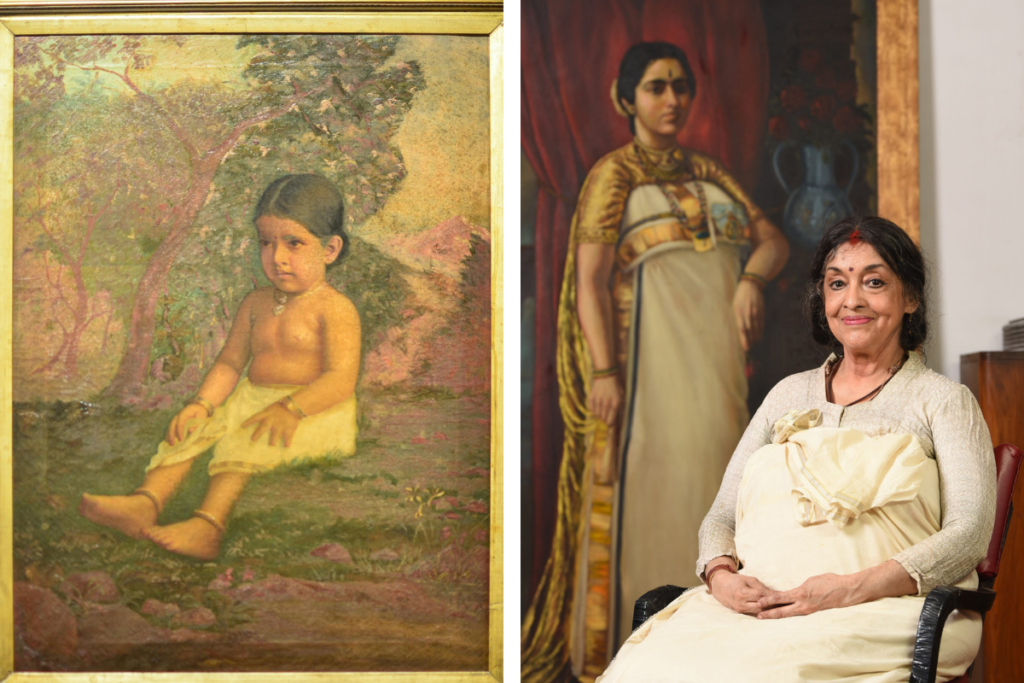We were at the preview of Daughter of Providence, an exhibition at the Raja Ravi Varma Foundation in Bengaluru showcasing a hitherto unseen work of Ravi Varma, when a realisation dawned on us. That no matter how unrelated you are to the world of art, there are certain artists who always find their way into your visual vocabulary because their presence is that integral to the cultural fabric of the nation. How else would you explain the presence of the crème de la crème of the city flocking to see a piece of art created by an artist who was born 175 years ago?
Perhaps it also speaks volumes about a person who inspires such an artwork. In the case of this never-before-seen artwork, Ravi Varma found his muse in his eldest granddaughter and the last ruling queen of Travancore – maharani Sethu Lakshmi Bayi. Conceptualised by Raja Ravi Varma Heritage Foundation, with research and documentation by historian Dr Manu S Pillai, Daughter of Providence is a first-of-its-kind exhibition featuring photographs and artworks on the life and times of this queen.
The never-before-seen, original oil painting is the centrepiece of the exhibition. It depicts maharani Sethu Lakshmi Bayi as a three year-old, painted as a present to her by Ravi Varma. It might have been hard for Ravi Varma to assume then that this adorable child would grow up to be one of the most powerful rulers the dynasty has ever had.
In several unorthodox moves, maharani Sethu Lakshmi Bayi not only opened the doors of her state’s legislature to non-royals but also appointed women to high positions. She also skilfully began to dismantle caste disadvantages and even supported the making of the very first feature film in Kerala.
The British, who otherwise looked at Indian royalty unfavourably, admitted that Lakshmi Bayi brought, “unexampled prosperity,” to her people. Revered by nationalists like Mahatma Gandhi and Rabindranath Tagore, she gracefully accepted change with the rise of democracy in India though. In the 1950s, she moved away from the palace and shifted permanently to Bengaluru. In 1985, she died an ordinary citizen.
The exhibition showcases a collection of photographs of the maharani and the many different chapters of her life, visually. The very first painting in the display, however, is an oil painting of Ravi Varma by the queen’s eldest grandchild bharani thirunal Rukmini Bayi thampuran aka Rukmini Varma, who’s also the chairperson of the Raja Ravi Varma Heritage Foundation. A glorious oil painting of maharani by Rukmini also grabbed our eyeballs.
If this story, so far, a blend of royalty and art, has gotten you intrigued, read on as we bring you a wholesome conversation with Rukmini Varma. An acclaimed artist herself, she opens up on being touted the favourite grandchild of the maharani, lesser-known stories of the queen’s life in Bengaluru, why Ravi Varma’s art is relevant even in the 21st century and lots more. Excerpts:
We’re celebrating the 176th anniversary of Ravi Varma. Why do you think his art continues to be significant even after so many years?
Because of its unique blend of European techniques and Indian sensibilities, which revolutionised Indian art! His realistic portrayals of Indian gods, goddesses and everyday life bridged cultural narratives, making divine and mythological characters accessible and relatable to a broader audience. By pioneering lithographic printing in India, he ensured his artwork was widely disseminated, embedding his aesthetic into the collective consciousness of India.
On entering the exhibition, the first piece we noticed is a painting of Ravi Varma by you. Can you tell us a bit about it?
It’s a portrait that I painted some years ago, based on my memory of him from several photographs that I had seen in our family albums. I also added stature to the image that I visualised from my understanding of him as an artist and the kind of man he was.






